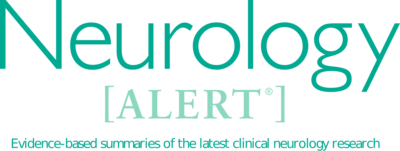
Neurology Alert – February 1, 2003
February 1, 2003
View Issues
-
Promising Novel Therapy for Multiple Sclerosis
In this randomized, double-blind trial, a total of 213 patients with relapsing-remitting or relapsing secondary progressive multiple sclerosis were assigned to 1 of 3 groups: natalizumab at 3 or 6 mg/kg (68 and 74 patients, respectively), or placebo (71 patients), by infusion every month for 6 months. -
Late Secondary Injury May Limit the Effectiveness of Thrombolysis
Within minutes of an acute cerebral ischemic insult, diffusion-weighted magnetic resonance imaging (DWI) demonstrates ischemic regions with a decline in the apparent diffusion coefficient (ADC) of water. ADC decline is associated with impaired high-energy metabolism and loss of ion homeostasis. Animal studies and preliminary observations in humans demonstrate that initial DWI and ADC abnormalities are reversible by early reperfusion. -
Blood Pressure Treatment for Stroke Patients: What Should Be the First Line?
The publication of the ALLHAT trial received much publicity not only in medical circles but was also front-page news in the Wall Street Journal. This trial was a significant blow to the pharmaceutical industry, and it convincingly showed that inexpensive diuretic medications had superiority over highly marketed ACE inhibitors and calcium channel blockers for the treatment of hypertension. -
Do Statin Drugs Prevent Dementia? Data from the PROSPER Study
Among patients with coronary artery disease, HMG CoA reductase inhibitors (statins) are a mainstay of therapy. These drugs have also become widely prescribed with a low threshold to patients with elevated cholesterol and even minimal cardiac risk factors. -
IVIG for MG
Intravenous immunoglobulin (IVIG) is safe and effective therapy for acute exacerbations of myasthenia gravis (MG), myasthenic crisis, and for optimizing patients conditions in preparation for thymectomy. Its role in the long-term management of MG remains to be defined. -
Homocysteine and Dementia
Three recent studies have provided further evidence linking elevated homocysteine levels to brain atrophy and cognitive dysfunction, as well as a decline in physical function. -
In Epilepsy, Not All MRI Scans are Created Equal
Among patients undergoing epilepsy surgery for pharmacologically refractory seizures, detection and excision of a structural lesion congruent with the electroencephalographic ictal onset is a strong predictor of a seizure-free outcome. -
Clinical Pearls in Differentiating Junctionopathies, Histologic Pearls in Defining IBM
Overlap of symptomatology can make differentiation of myasthenia gravis (MG) from Lambert Eaton myasthenic syndrome (LEMS) challenging. Among 101 patients with MG and 38 with LEMS, clinical features allowing more accurate differential diagnosis are noted. -
Pharmacology Watch: FDA Issues ‘Black Box’ Warning Based on WHI Study
ALLHAT: Thiazide for Hypertension Treatment; Candesartan Effective Against Migraines; Cough! No Cold Relief from Echinacea; COX-2 Inhibitors and GI Benefits Could Be Overrated; FDA Actions -
Clinical Briefs in Primary Care
